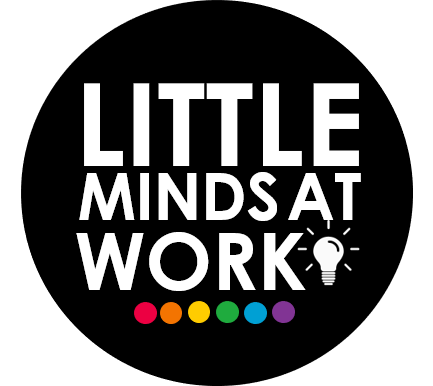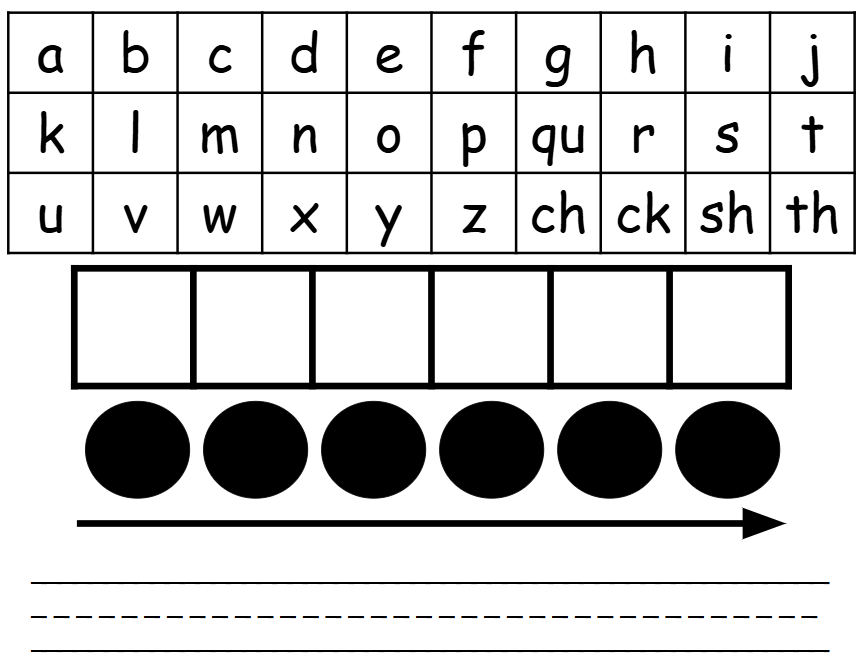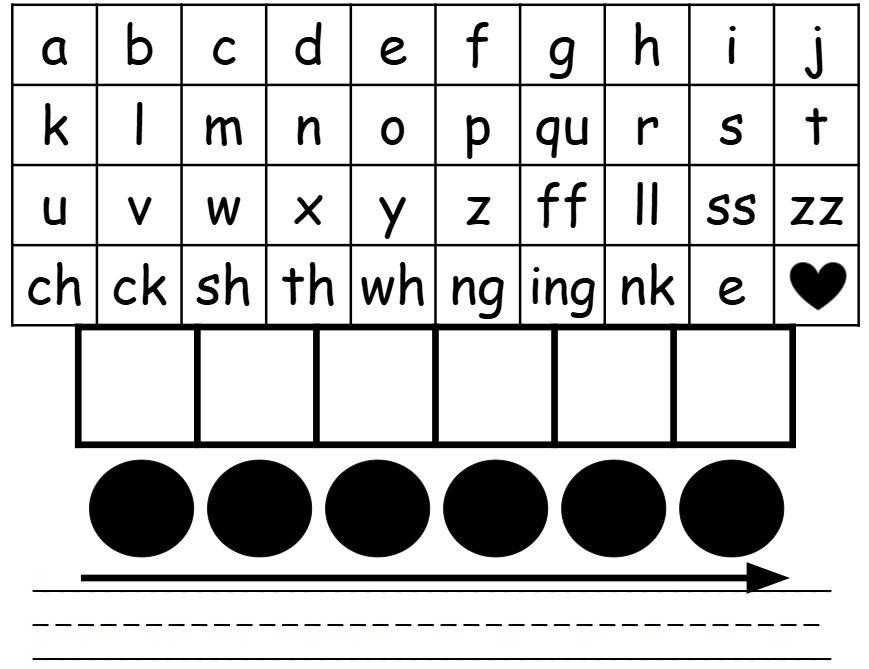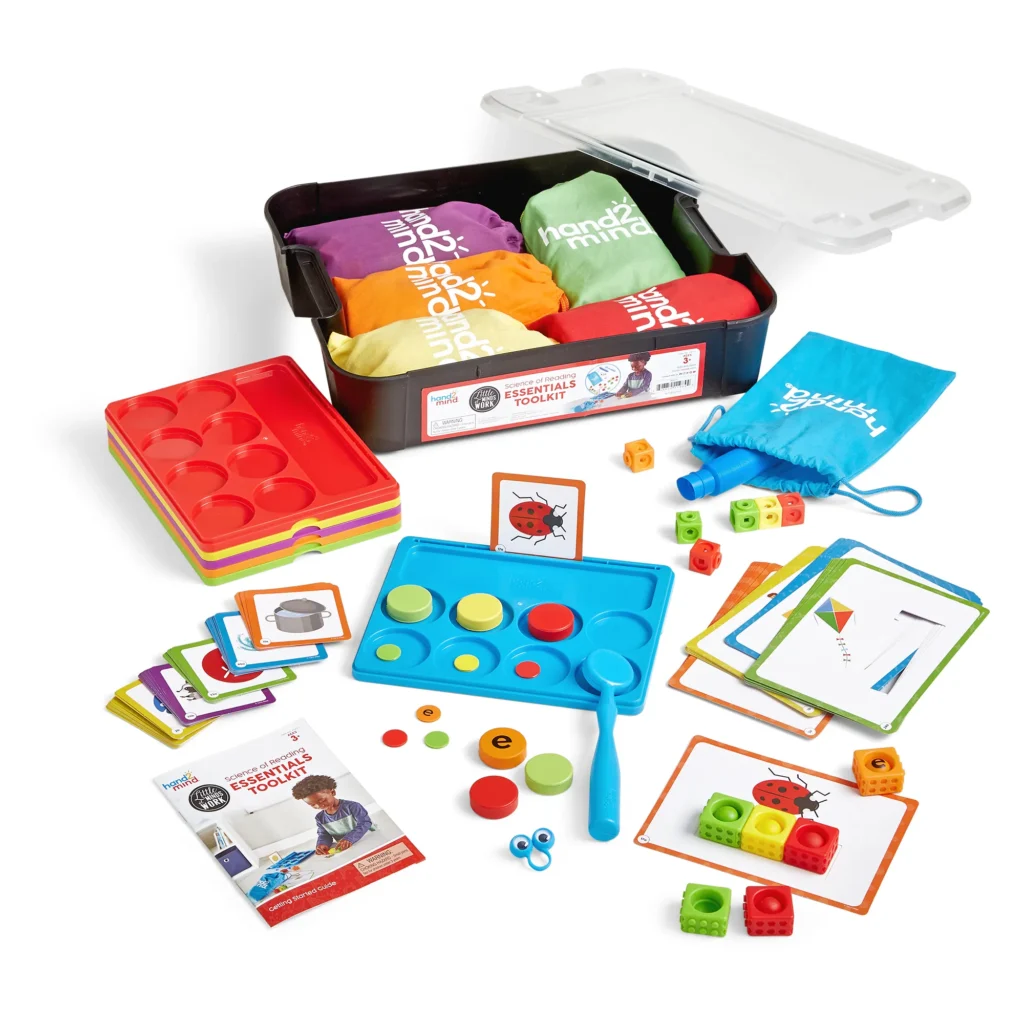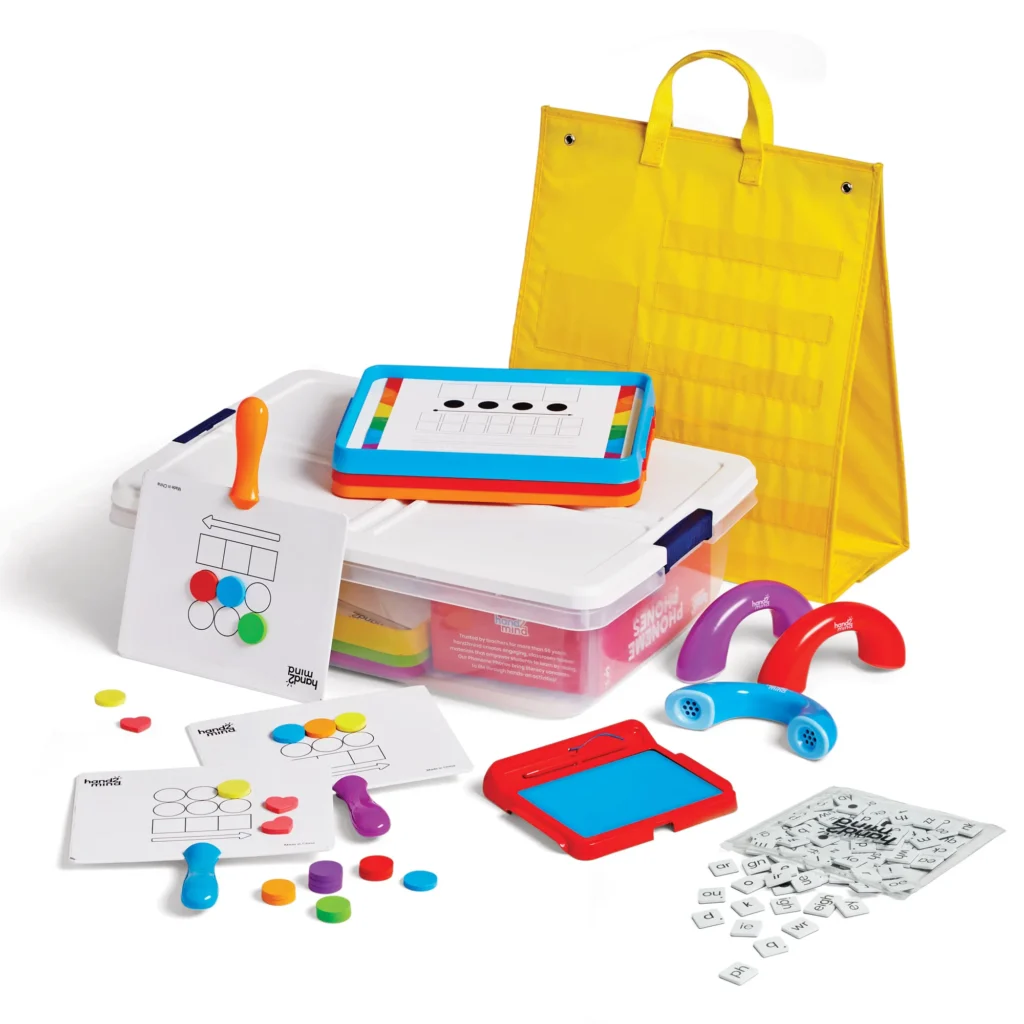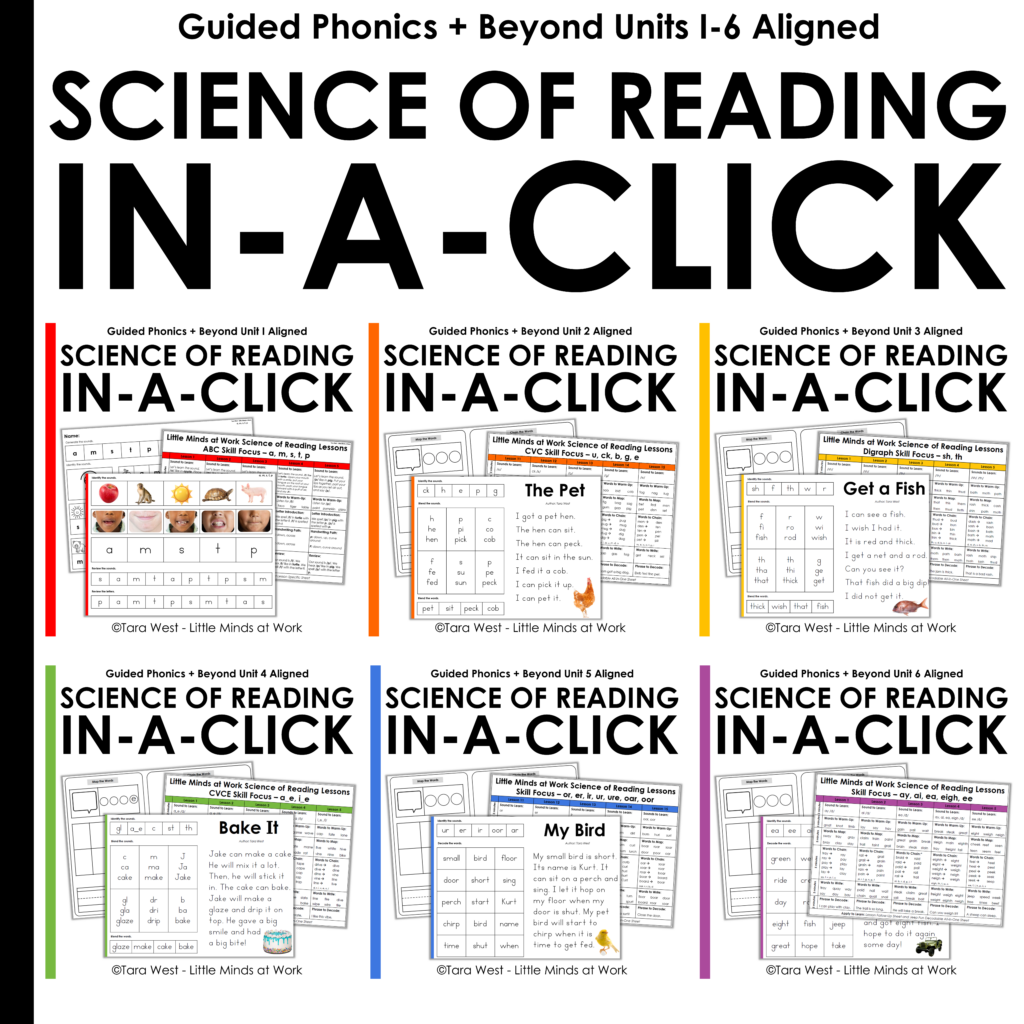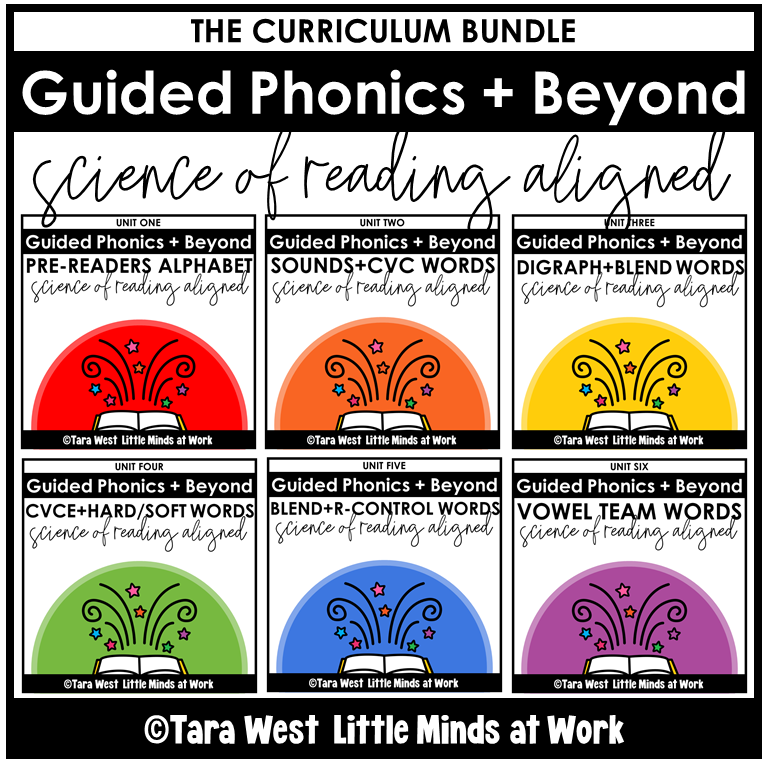Ready to Transform Your Phonics Small Groups? Meet the Go-To Cart!
This phonics post is part of our Community Member Guest Series and was written by Kristen Shawley. Enjoy! This post contains affiliate links. As an Amazon Associate, I earn from qualifying purchases at no extra cost to you.

My name is Kristen. I’m a first grade teacher in Maryland and I have been using Guided Phonics + Beyond resources since they were launched in 2021! I’m excited to share my SOR cart and how I use the Little Minds at Work™ Science of Reading Essentials Toolkit and the Guided Phonics + Beyond® Focus Lessons Small Group Resource Kit paired with the In-a-Click Lessons and Guided Phonics + Beyond decodable books.
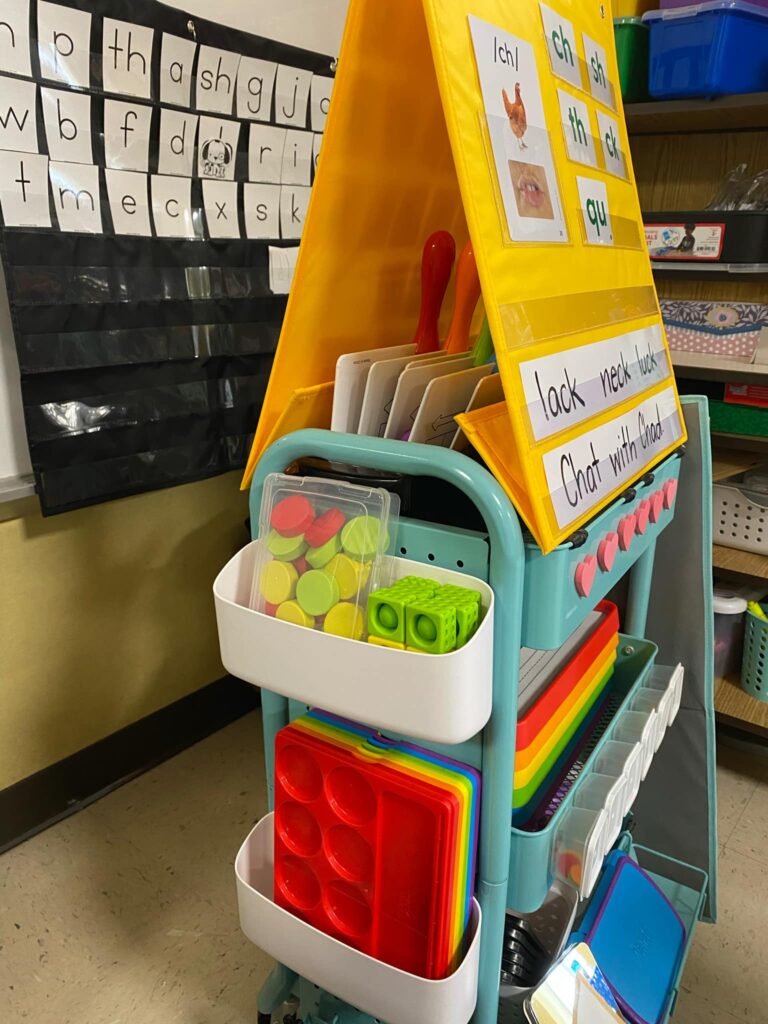
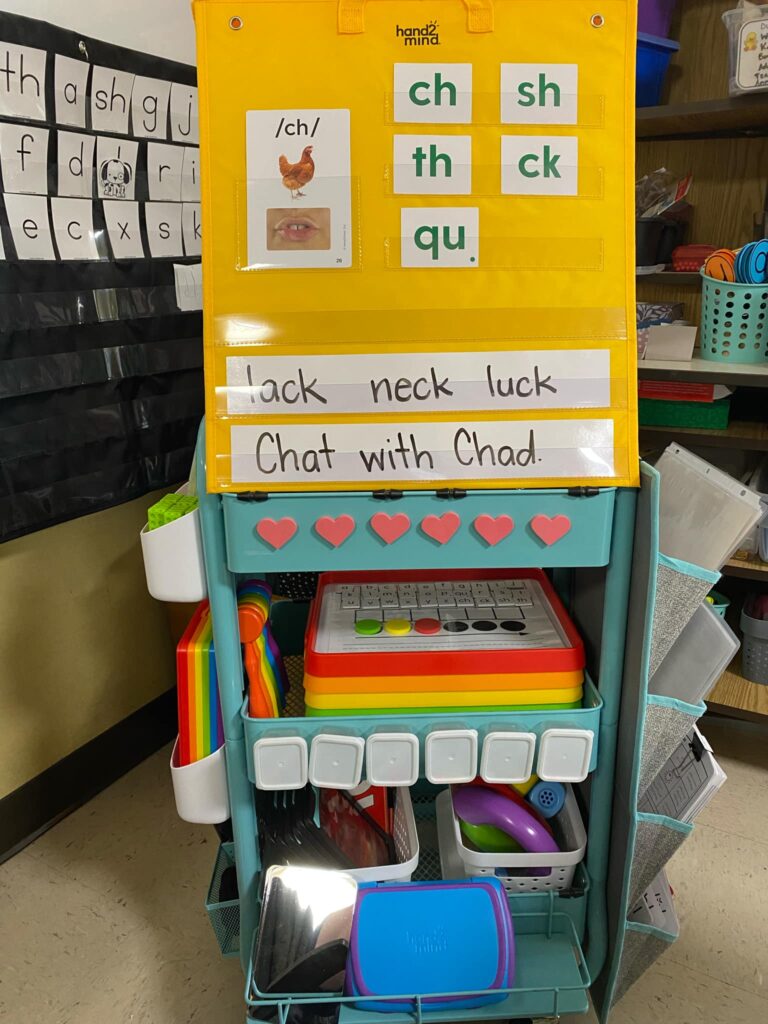
In our school district, we are blessed to have access to some great programs for phonemic awareness and phonics for our whole group instruction, so I use the In-a-Click Lessons and Guided Phonics + Beyond decodable books for my small groups. While the scope and sequence is a little different, I find that the Guided Phonics + Beyond scope and sequence aligns closely enough that I am able to use the programs together very well.
I am also fortunate to have extra support staff who are available to help with small groups in my classroom and I have found that these lessons are simple to follow and save me so much time planning for multiple groups and the staff members who will meet with them. I love the predictable routine that makes it simple to print and teach and how I can use manipulatives to make the lessons more effective, engaging and fun for my students.
The Phonics Small-Group Reading Cart
Let’s start with the part that makes our teacher hearts happy… organization. This cart has places for all of the things that I use most often. I can pull it up to my teacher table and have everything that I need at my fingertips.
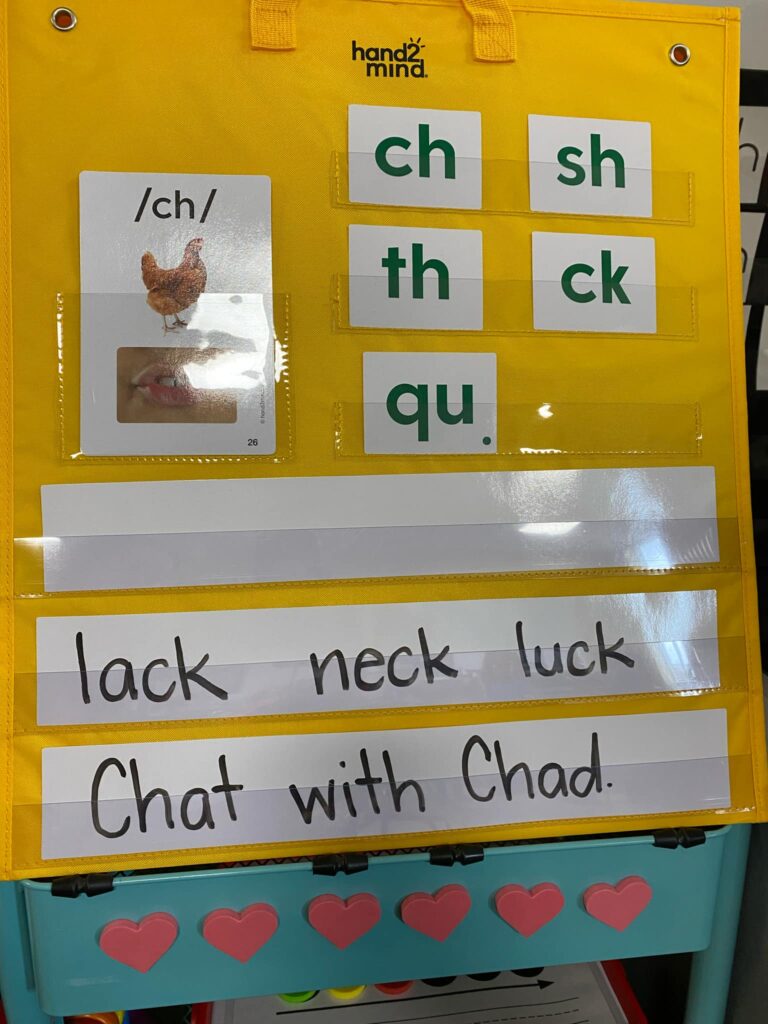
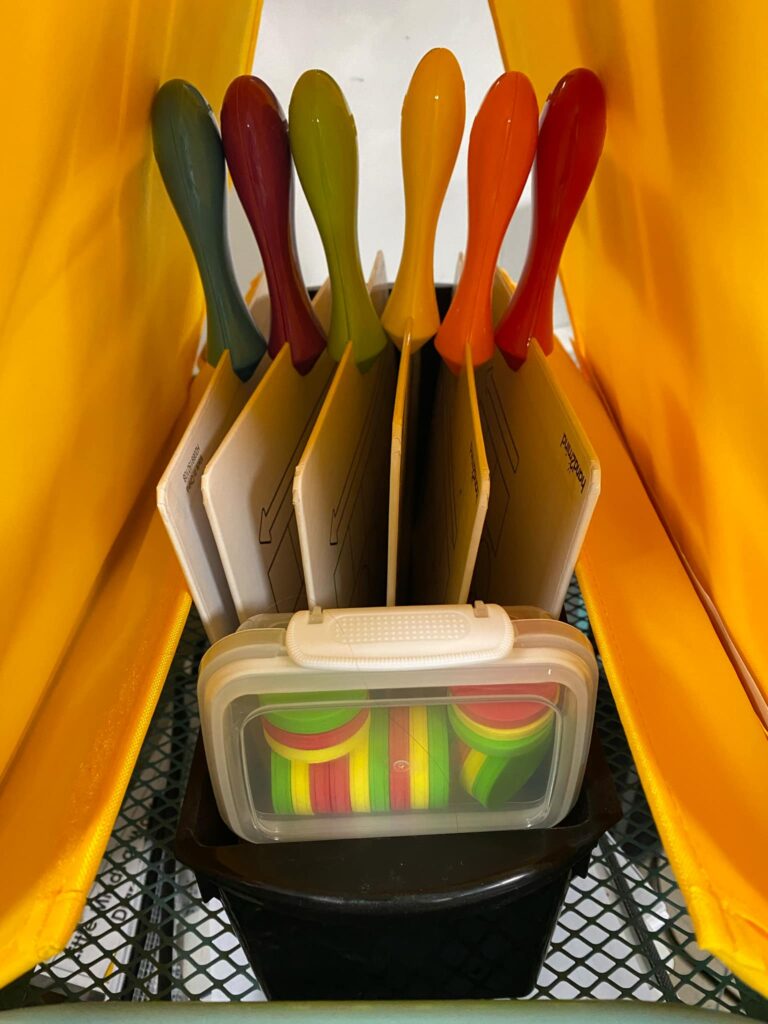
The Phonics Cart: Top Shelf
On the top of the cart, I have the Phonics Skill Building Pocket Chart as well as the Elkonin Box Magnetic Answer Boards from the Guided Phonics + Beyond Focus Lessons, Small Group Resource Kit. When I have my life together, I write the “Words to Warm-Up” and the “Phrase to Decode” from the In-a-Click Lessons on the reusable sentence strips. I also like to have the sound cards for the sounds we are working on and the double sided grapheme cards that come with the pocket chart displayed for reference and quick reviews. The magnetic answer boards are stored in a Storex book box that I got from amazon and the magnetic counters are in clear crayon boxes from Dollar Tree. I put the hearts on the front of the cart for easy access and because they are so cute.
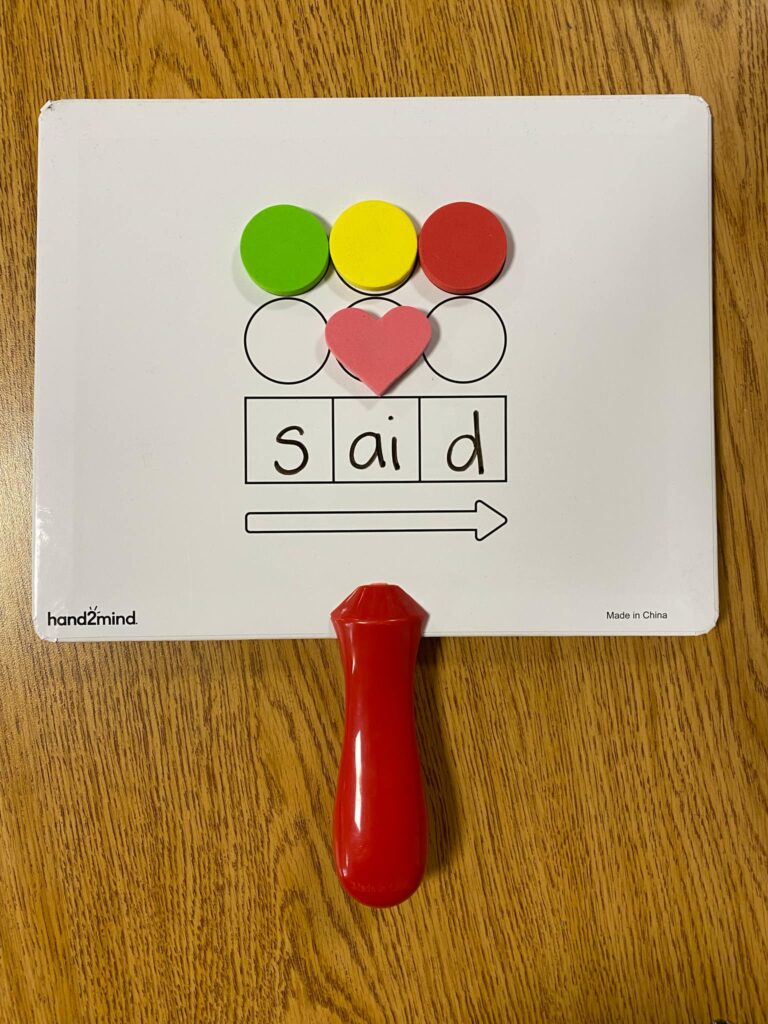
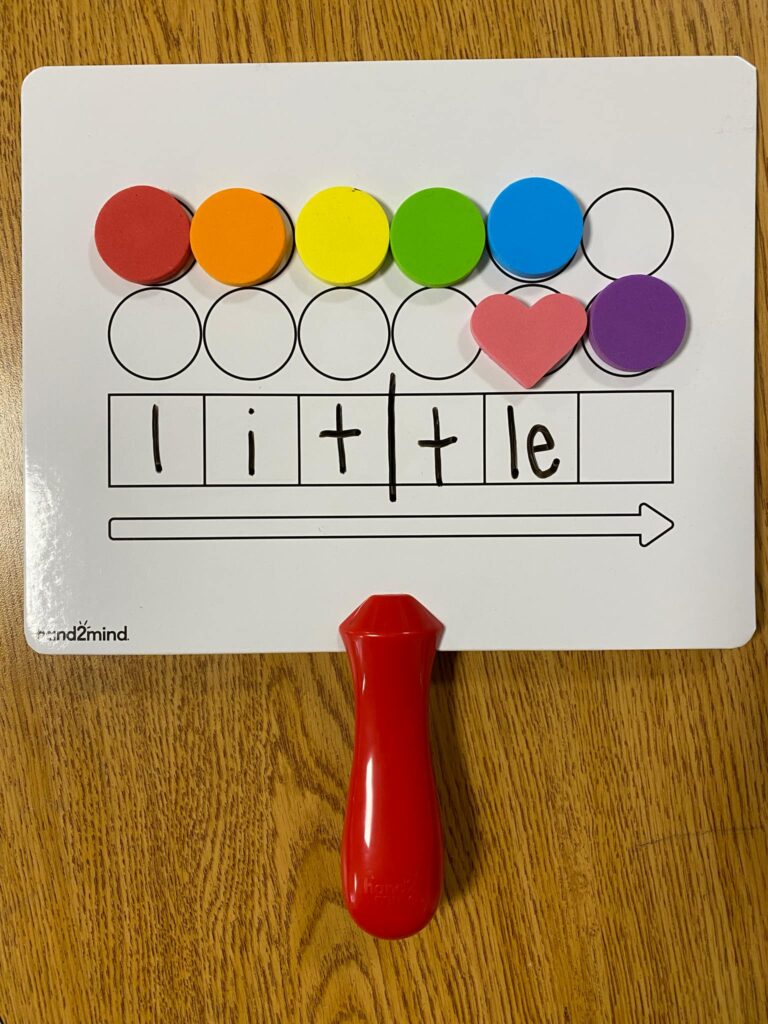
The Elkonin Box Magnetic Answer Boards are great for mapping and reviewing high frequency words. Students can use the colored counters to map the sounds and then write on them with dry erase markers. For this routine, I have students place the counters in the middle row. Then, I will say the word, have students repeat the word, push up a counter for each sound and identify how many sounds are in the word and then we map the word together by saying each sound and writing the letter or letters that spell that sound in the word.
They love using the heart magnets to identify the tricky part of the word. You can preview your decodable book or passage and use this method to review the high frequency words before they read.
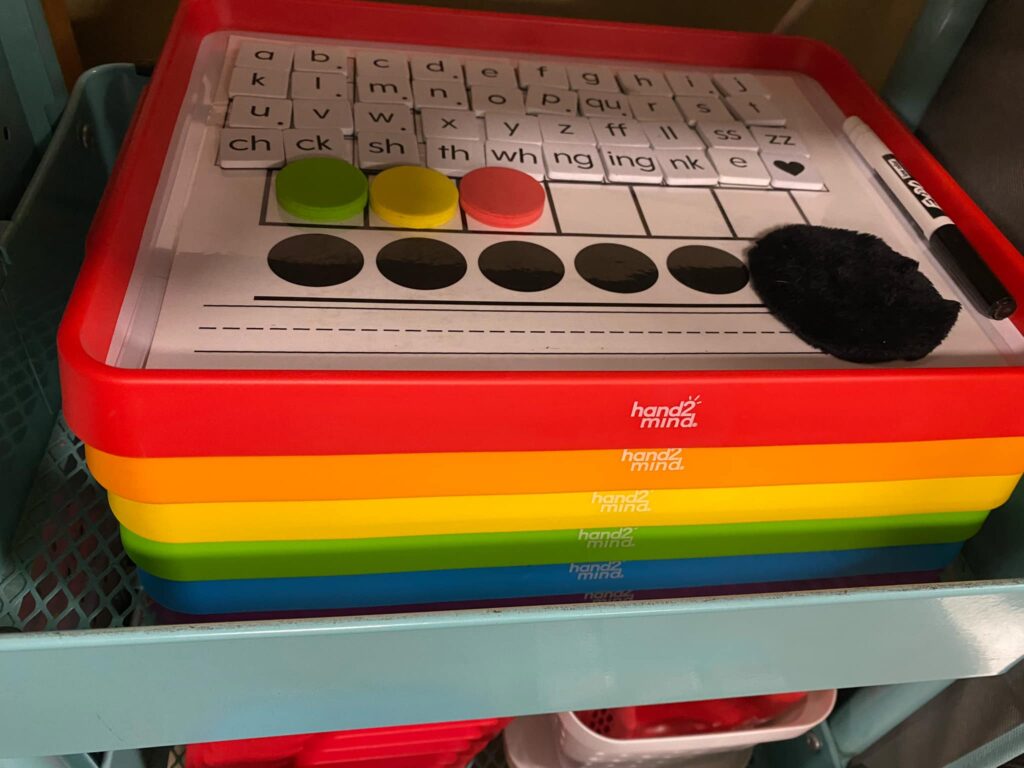
The Phonics Cart: Top Shelf
On the middle shelf, I have the magnetic trays with the word work mats and magnetic tiles from the Guided Phonics + Beyond Focus Lessons, Small Group Resource Kit. These are probably the most used item on my cart and they are an awesome resource to make the In-a-Click Lessons so easy to do with small groups. There is room to keep a thin marker and eraser on each tray along with the letters and colored magnetic counters so everything is ready to go. I created two different options for word building mats to use with the letters that we use the most in small groups. They are laminated so students can write with a thin dry erase marker. I do not have them attached to the trays (the magnetic letters keep them in place). You can grab those by clicking the images below.
The Phonics Cart: Bottom Shelf
On the bottom shelf, I have the Letter Tracing Sensory Pads, the Rainbow Phoneme Phones, (from the Guided Phonics + Beyond Focus Lessons, Small Group Resource Kit) the Mirror My Sounds Phoneme Mirror from hand2mind and small containers from the Dollar Tree with the magnetic chips from the Little Minds at Work Science of Reading Essentials Toolkit. (Please note that I tried attaching magnets to these containers and putting them on the front of the cart, but they kept falling down.) The letter tracing sensory pads are perfect to grab to work on handwriting and letter formation in a multi-sensory way. I like to use them for a quick review of letters / sounds as a warm-up for our small group.
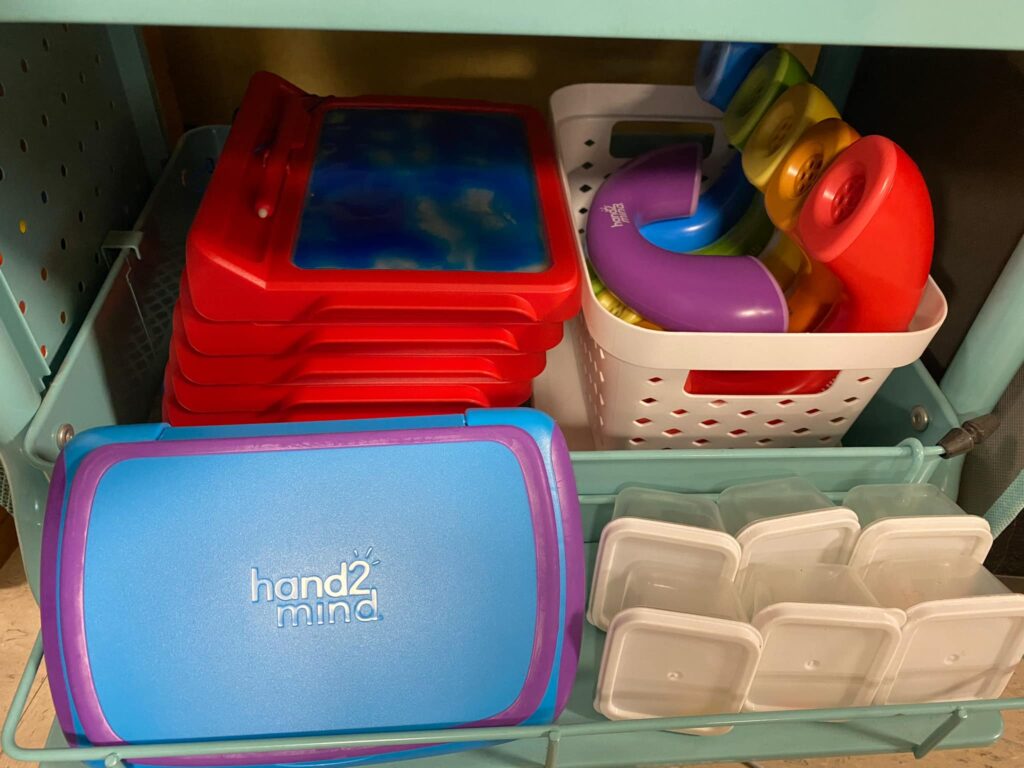
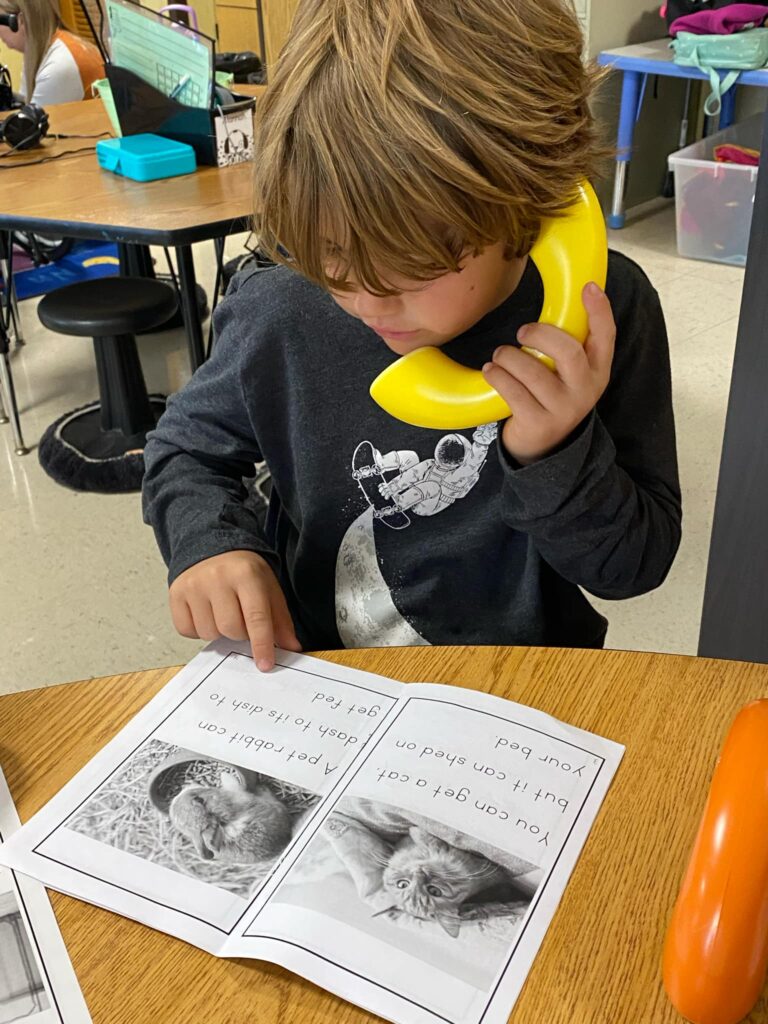
The phoneme phones are so helpful when students are reading their decodable books at our small group table. The phones allow them to whisper read to themselves and then I am able listen in to each child to offer support and to do quick informal assessments. We use the magnetic chips to map sounds for dictation or phonemic awareness activities.
The Phonics Cart: Left Side
I found magnetic bins that fit perfectly on the side of the cart. They hold some of my favorite items to make small group time more engaging and to reinforce important phonemic awareness and reading concepts. On the top, I keep the Press’ems and Bubblebrix from the Little Minds at Work™ Science of Reading Essentials Toolkit. These manipulatives are perfect for phonemic awareness as students can press them for each sound in a word.
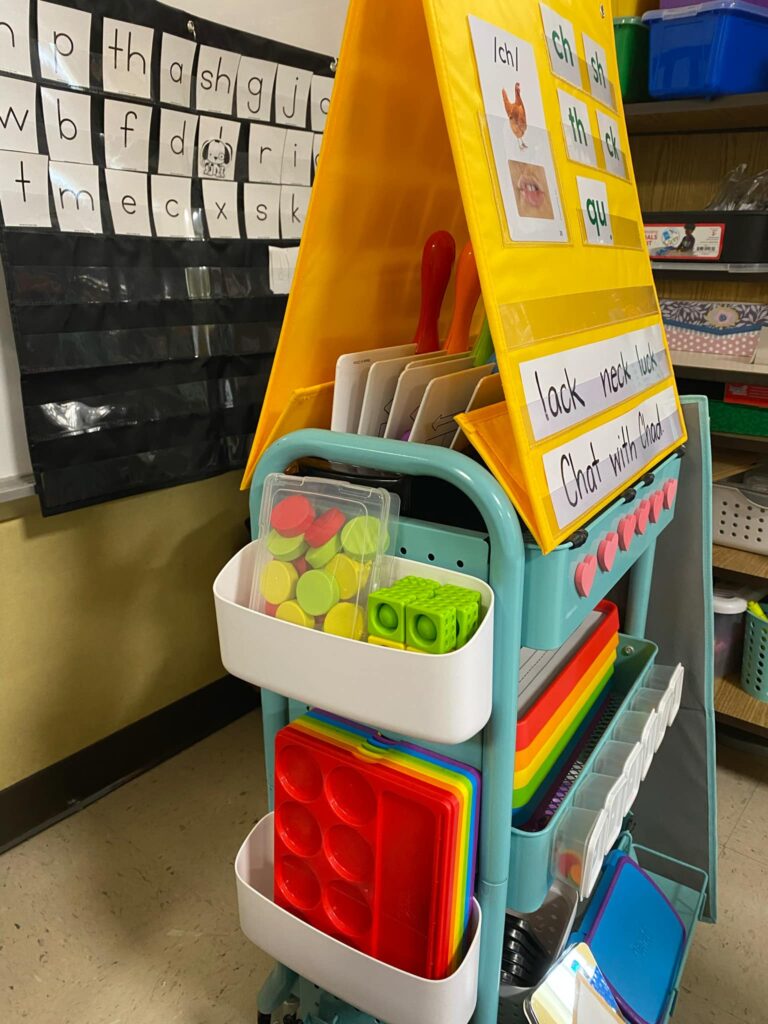
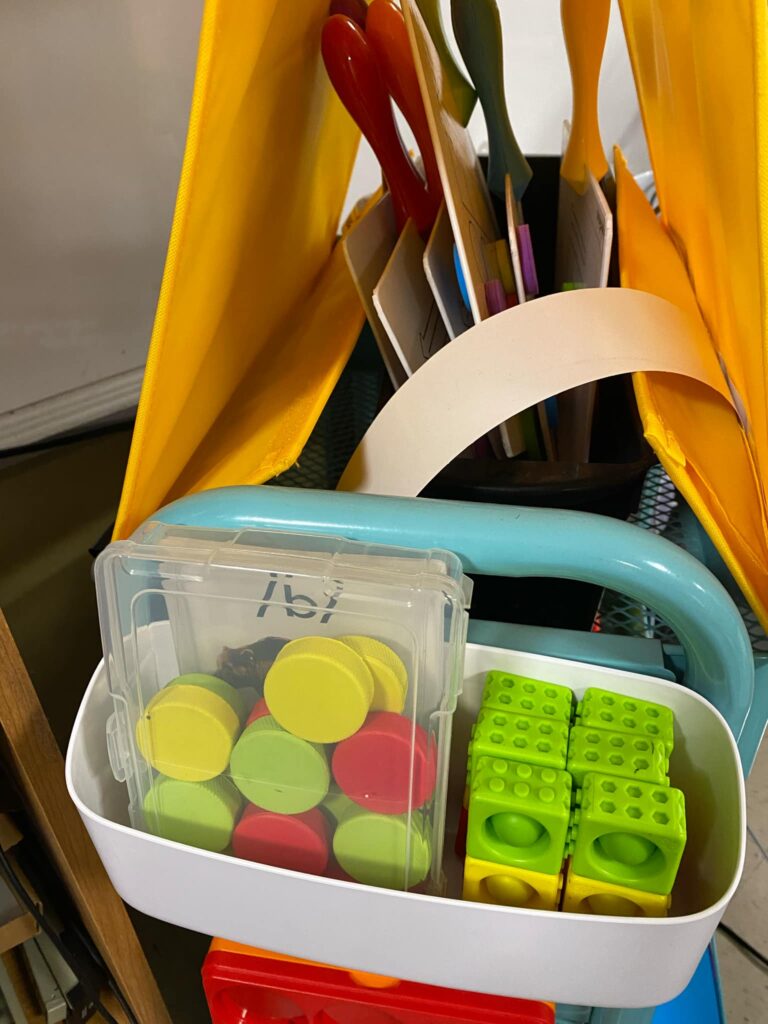
They can be used on their own or paired with magnetic letters or the Sound Segmenting Trays from the toolkit. The set of 6 trays fits perfectly in the magnetic bin (in rainbow order, of course) and those bins are strong enough to hold those items without slipping or falling. On the bottom of that side, I store the magnetic wands from the toolkit in a storage basket that came with the cart. Students love using the magnetic wands to collect the magnetic chips after mapping the sounds in a word.
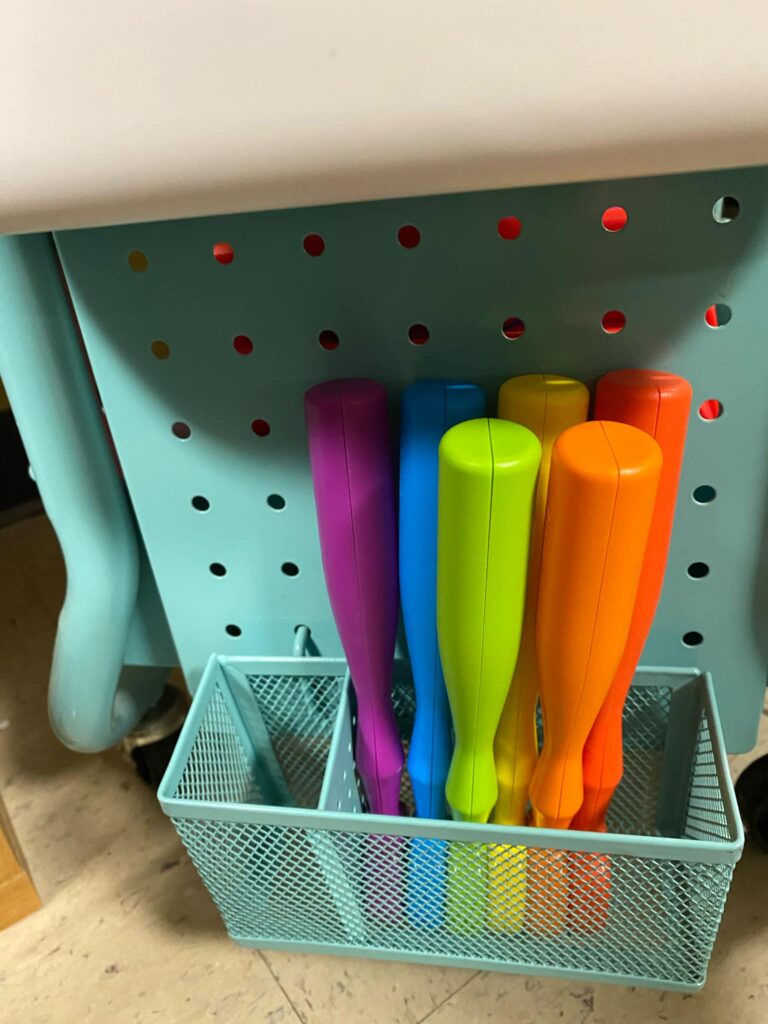
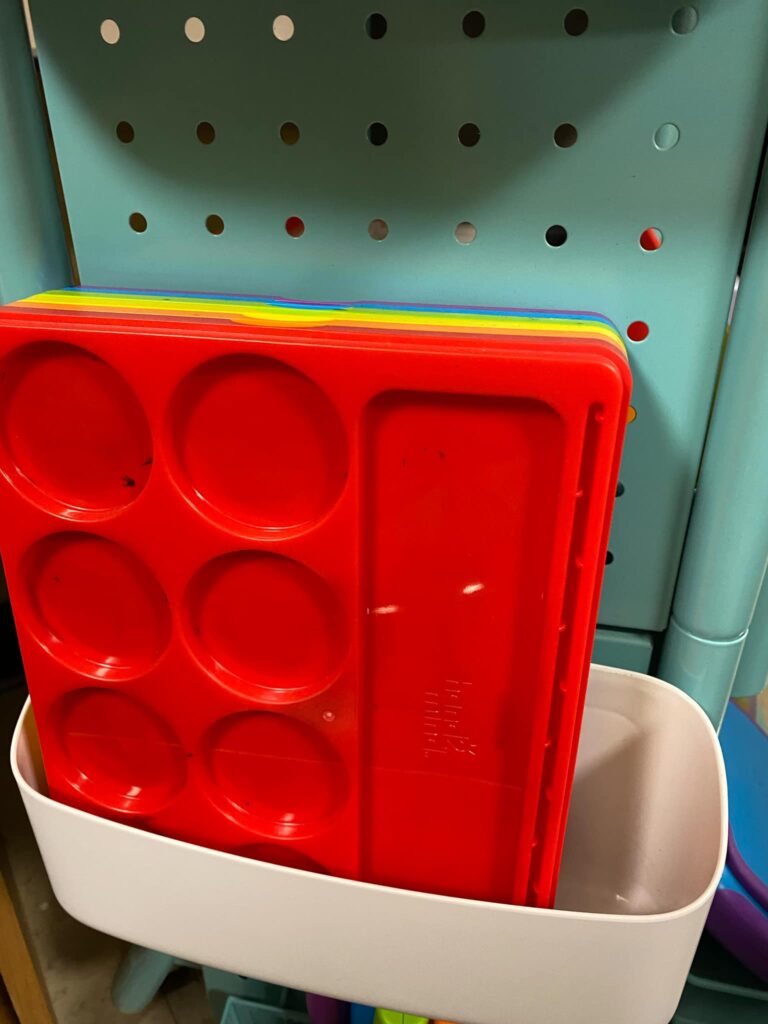
The Phonics Cart: Ride Side
I zip tied a hanging file folder holder to the side of the cart. This holds my In-a-Click Printables for each group. I keep one week in each mesh zipper pouch including the laminated lesson plans, decodable all in one sheet and any decodable books that I want to work on that week. As I am blessed with additional help in my room for small groups, this keeps the lessons organized and makes it easy to grab what is needed for small groups. We use a dry erase marker to check off the lesson at the top after completing it so that whoever is working with the group will know where that group left off.
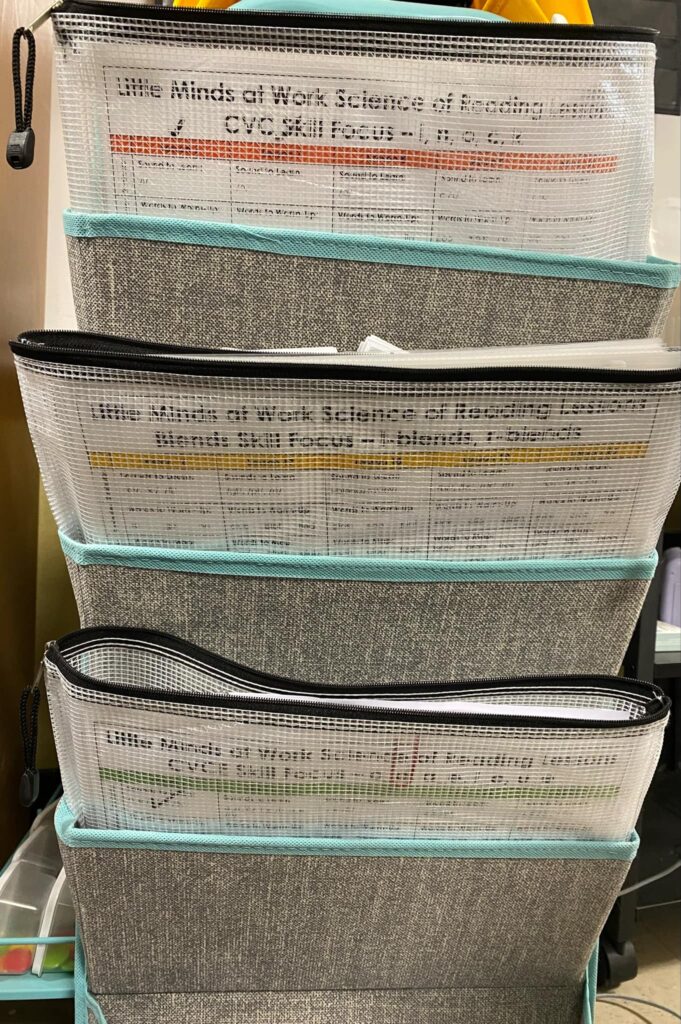
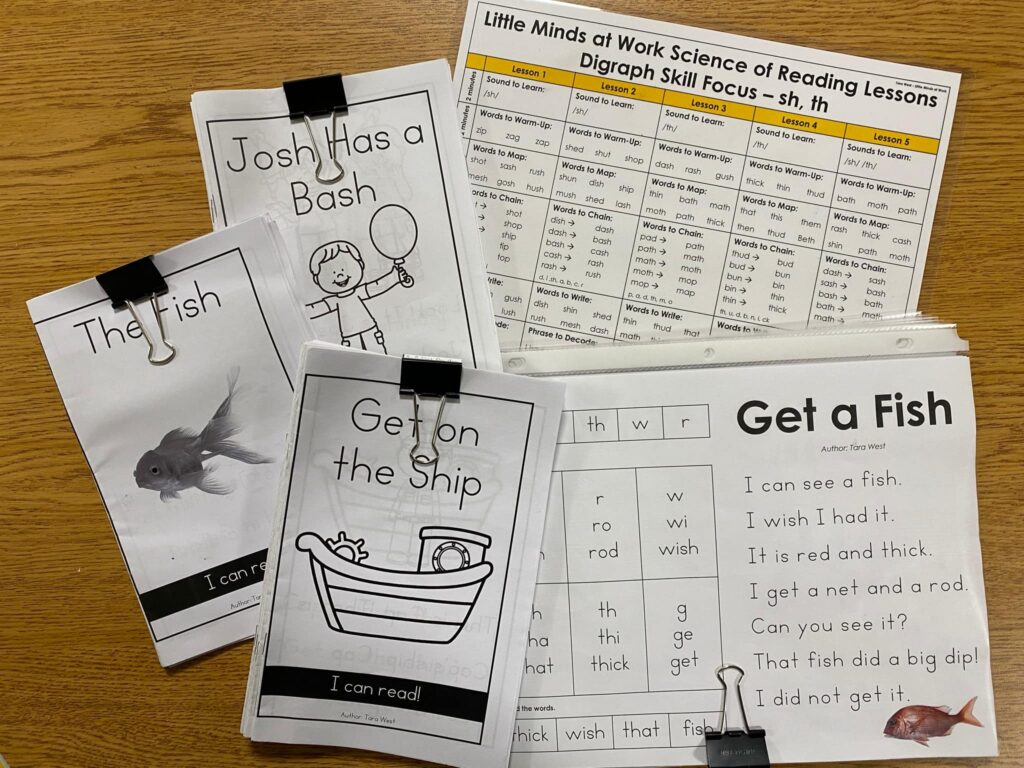
Decodable Book Organization
I have my decodable books organized by unit with labeled binder clips to indicate the unit, lesson and title of the story. This has been a huge time-saver for planning groups since Tara is so diligent about aligning her scope and sequence across her programs. If I’m using the In-a-Click lessons, I can quickly choose decodable books or passages that will align to the lessons to keep things engaging for students or to add additional practice opportunities as needed.
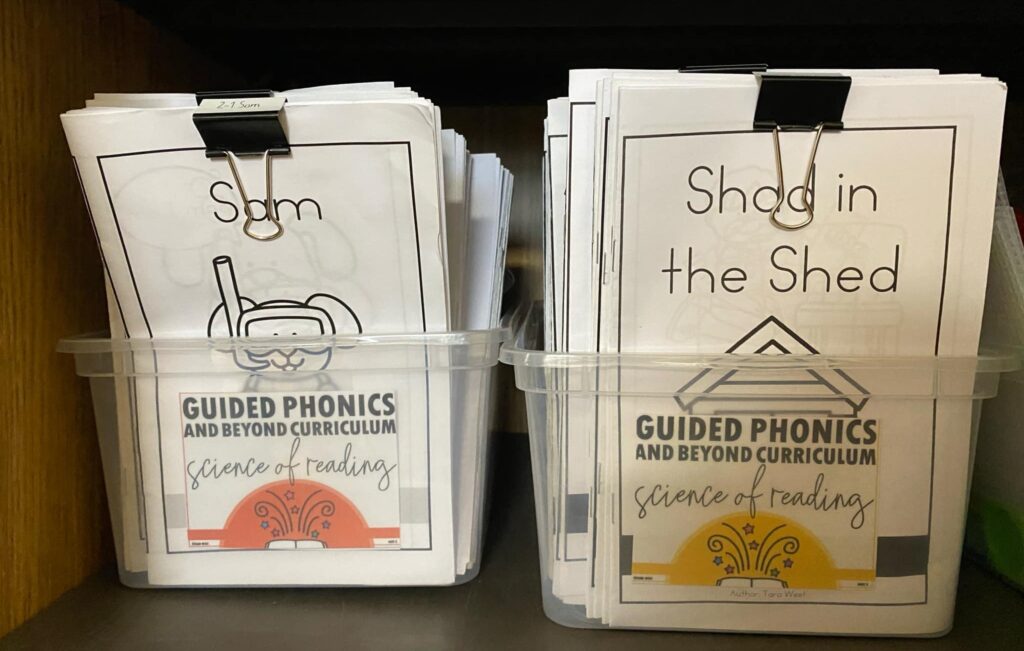
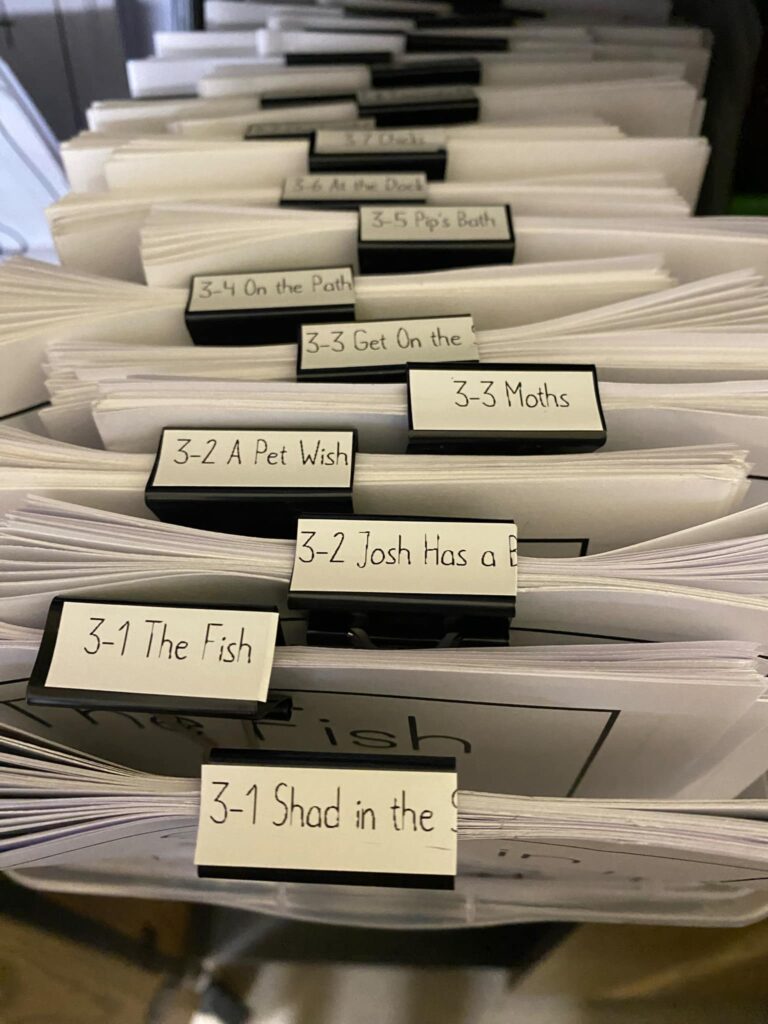
Phonics Small-Group Structure
I generally have about 35 minutes for small groups each day. While I am meeting with my small groups, my students are busy reading their decodable books from my decodable book library, books from our classroom library or listening to books on Epic. I love using Epic for my beginning readers as I can create collections of books that they can listen to to build vocabulary and background knowledge.
This year, I am so blessed with extra support for my 24 first graders, so I have 4 groups (2 below level, 1 on-level and 1 above-level). As of December, one of my below-level groups is working through unit 2 (CVC). My next group is almost finished with unit 3 (digraphs and blends), the next group is working through unit 4 and my final group is working on making presentations in Google Slides. I generally have that group work on comprehension and writing.
My Unit 2 group meets with me a day a week and with an instructional assistant the other days. They also have another small group time later in the day during RTI. My Unit 3 group meets with me 3 days a week and then I alternate between the other two groups for the final day of the week and I have an instructional assistant that meets with the Unit 4 group two days a week. I realize this is an ideal situation, but I am so thankful for the level of support that I have during that small group time.
Phonics Small-Group Structure Continued
With less support, I would probably try to split my time into 20 minutes daily for my Unit 3 group and then meet with the Unit 4 group for 15 minutes 3 days a week and my enrichment group 2 days a week. I do feel that for those students who are working below level, you really need 20 minutes to do a solid group session with them.
I also adjust my pacing based on the needs of the group. For example, my Unit 2 and 3 students may repeat lessons for more reinforcement and then I can add in additional decodable books or passages that align with the lesson they are working on. I want to keep them moving as quickly as possible while also ensuring they are mastering the concepts. For groups who are able to move more quickly and are working beyond where we are in our whole group lessons, I do not complete every lesson (especially if they are only meeting with me 2-3 times a week. I feel okay skipping some lessons because the skills will be covered in whole group lessons when we get there. For example, I may only do 2 lessons on i-e rather than all of the lessons included.
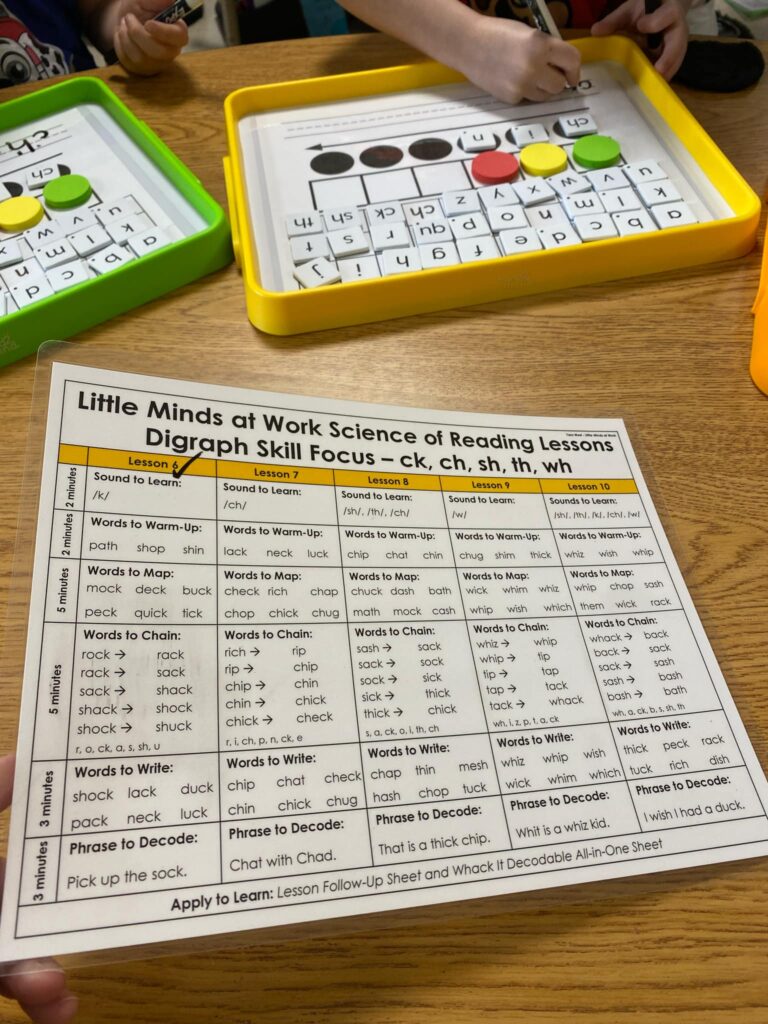
Taking a Closer Look
The In-a-Click Lessons have really streamlined my small group time and they make it easy to keep each group moving through the lessons and organized with different staff members working with the groups. I also love how they are low-prep, color-coded based on unit, and when laminated, you can reuse them over and over. The lesson plan includes phonemic awareness, phonics, encoding, decoding, segmenting and blending – so many skills covered within a predictable structure and easy to follow plans that you can literally just print, pick up and teach!
Below is a quick walkthrough of how I teach each section of the lesson:
Sounds to Learn:
For this section, I quickly review previously taught sounds. The plan includes suggested sounds, but I will often add a few more based on the needs of the group. I use the double-sided grapheme cards that came with the phonics skill-building demonstration pocket chart that is included with the Guided Phonics + Beyond Focus Lessons.
Words to Warm Up:
For this section, I just write the words on dry-erase sentence strips that go with the pocket chart or sometimes just on a dry-erase board. I point under each letter and we say the sounds and then blend the word together.
Words to Map:
For this section, I give students manipulatives such as the Press’ems or Bubblebrix. I say each word and then they say and pop the sounds. For beginning or ending blends, I add additional manipulatives so they are popping or pressing for each sound. For example, for the words sloth, flock and gloss, they would have green, green, yellow, red.
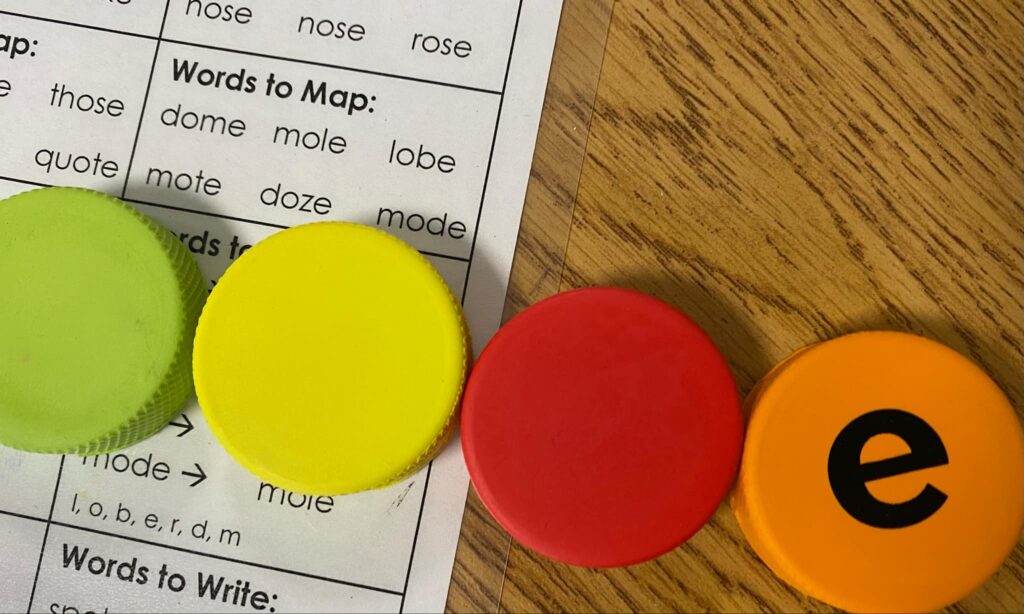
They would press two greens to pull apart the beginning blend and then yellow for the middle and red for the ending sound. Since sh, ck and ss are all one sound, they would only pop once even though there are two letters used to spell that sound. For magic e, I would give them green, yellow, red, orange and I like to have them press the yellow and orange at the same times as the vowel and magic e are working together to make that sound.
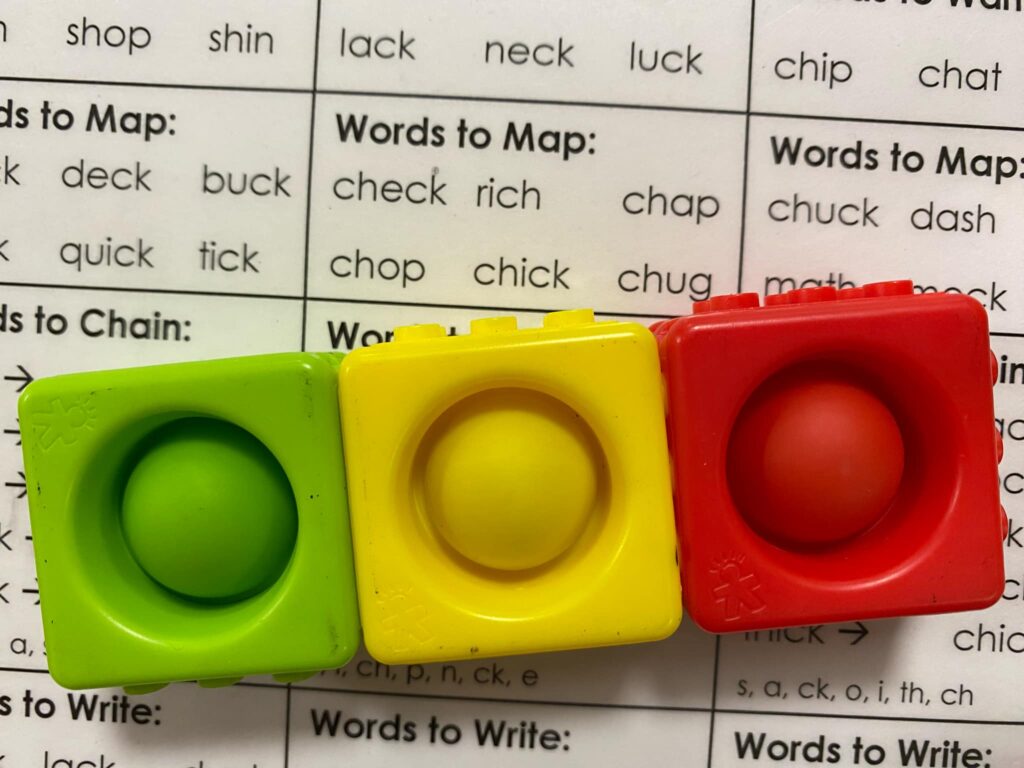
Words to Chain:
For the rest of the lesson, I generally use either the magnetic letters / tray. You could also use the sound segmenting trays for this. Students start with the magnetic counters in the squares on the mat. I say the word aloud and they repeat the word. Then, they press a counter for each sound and choose the tiles to spell each sound in the word. I check in with them as they finish and prompt them to correct any mistakes. Once they have spelled the first word, I will tell them the next word and they press a counter for each sound in the word, check for what is different and change only the sound that they need to change in order to spell the new word. We continue that process for each word.
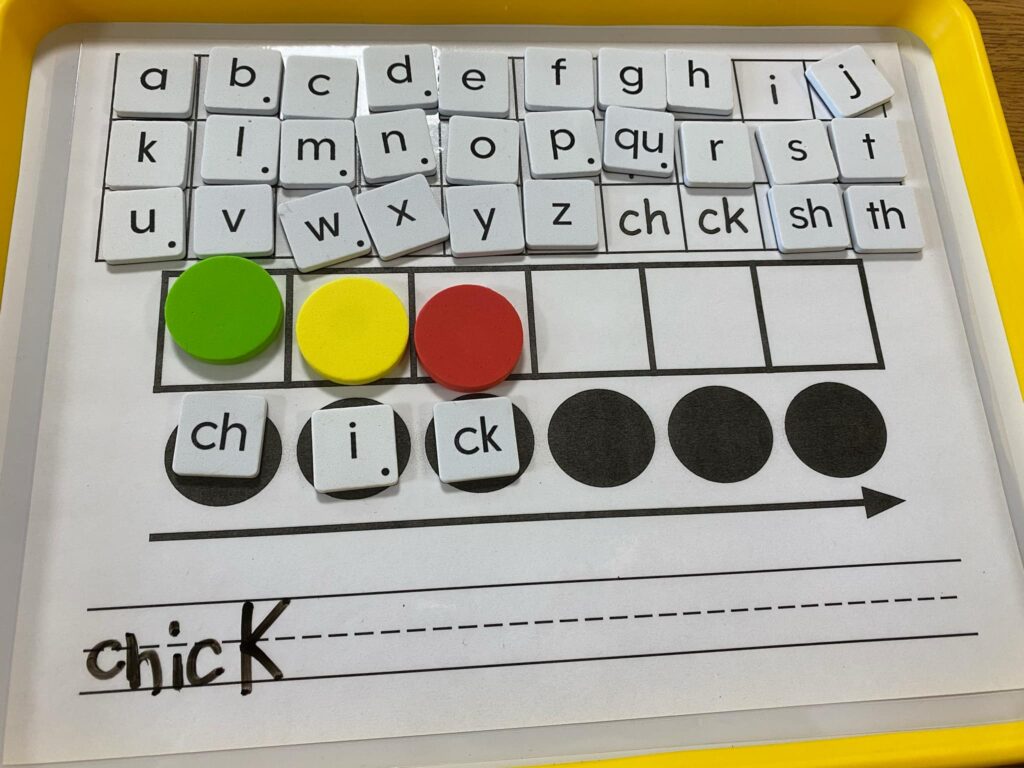
Words to Write:
For this section, I state each word and students repeat the word, pound / tap the sounds (according to our OG method) and write the word. I check in with students and help them correct errors as needed and then give them the next word to write. I try to do at least 3 of the words. If we are running short on time, I move on to the next section after that.
Phrase to Decode:
For this section, I will have the phrase to decode written on a sentence strip. We read the phrase together and then I generally give them the decodable passage for the week of the decodable text that I want them to work on. This part really depends on the time we have available and based on the needs of the group, I may start the next day with the passage / book to make sure we get to that so they have the opportunity to apply the skills that they are learning.
In Closing
I hope this gives you a little glimpse into my classroom and how the Little Minds at Work™ Science of Reading Essentials Toolkit and the Guided Phonics + Beyond® Focus Lessons, Small Group Resource Kit paired with the In-a-Click Lessons and Guided Phonics + Beyond decodable books have made my small group time easy to manage and so effective for my students!
Thank you so much Kristen for your insightful and thorough post. This is going to help so many educators visualize what a small-group phonics cart might look like in their classroom!
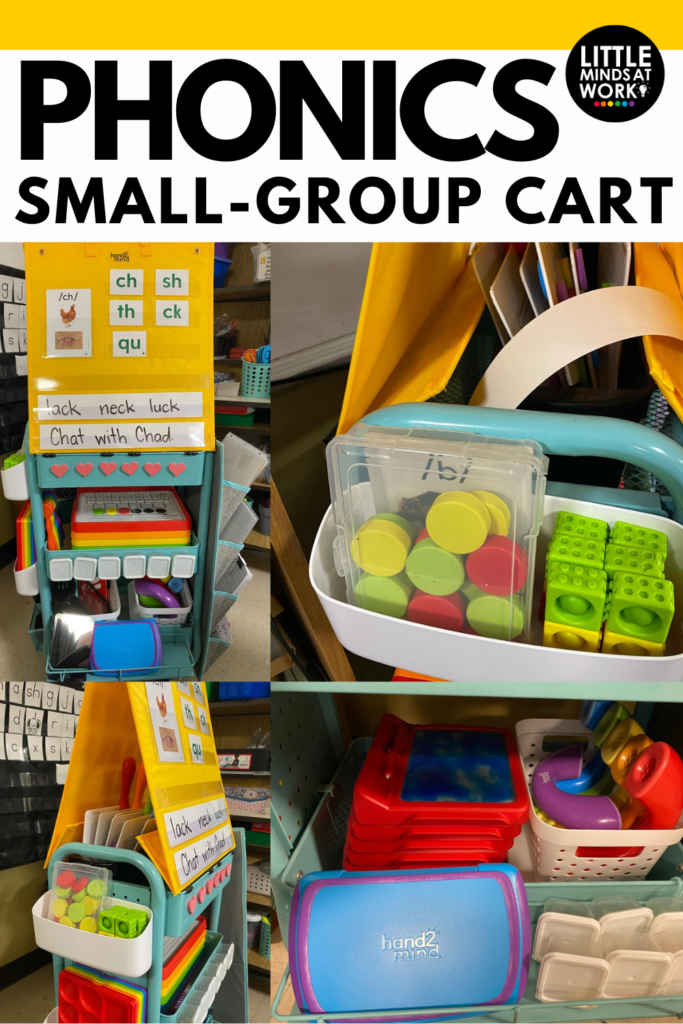
A One-Stop Shopping Link
Are you considering creating your own phonics small-group cart? I’ve compiled an easy shopping spot where you can shop items used in Kristen’s small-group phonics cart!
👉 Shop the Phonics Small-Group Cart on Amazon
Kristen’s cart is from Michaels. View it here.
Phonics Resources Wrap-Up
Kristen shared in detail how she pairs components from the hand2mind Science of Reading Essentials Toolkit with the Guided Phonics + Beyond Focus Lessons Small-Group Kit. You can view learn more about these resources by clicking below.
Would you like to learn about funding these hands-on hand2mind resources through DonorsChoose? Click HERE.
Science of Reading Small-Group Lessons + Decodable Books
Kristen shared a lot about using the Science of Reading In-a-Click Lessons to guide her daily small-group instruction. She also paired these lessons with the Guided Phonics + Beyond decodable books. Learn more about these resources by clicking the images below.
Small-Group Resource Kit Giveaway
I am excited to host a giveaway for the Guided Phonics + Beyond® Focus Lessons, Small Group Resource Kit. The Guided Phonics + Beyond Small Group Resource Kit, valued at $299.99, is an essential tool for effective small group instruction. Packed with high-quality hands on materials, it’s designed to enhance phonics learning and student engagement. Enter the giveaway below or by clicking HERE. Giveaway runs 1/11/25-1/18/25.
a Rafflecopter giveawayThank you for your commitment to building confident and proficient young readers. It is truly inspiring. If you have any questions or need additional support, feel free to reach out—I’m here to help!
Tara West – Little Minds at Work
littlemindsatworkLLC(at)gmail.com
